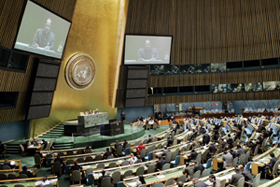The Tribunal’s judges are elected by the General Assembly of the United Nations.
The election process is initiated by the Secretary-General who invites UN member states and non-member, who maintain permanent observer missions at the UN Headquarters, to submit up to two candidates for the position of permanent judge.
All judges must meet the qualifications laid out in Article 13 of the Statute, which provides that they “shall be persons of high moral character, impartiality and integrity who possess the qualifications required in their respective countries for appointment to the highest judicial offices”.

The Secretary-General passes the names of the candidates on to the Security Council, which establishes a list of at least 28 and no more than 42 candidates for the position of permanent judge. The President of the Security Council forwards the list of candidates to the President of the General Assembly. From these lists, the General Assembly elects 14 permanent judges. A temporary increase in the number of ad litem judges to a maximum of 16 during the year 2008 was approved by the UN Security Council on 20 February 2008.
Candidates receiving an absolute majority of the votes are declared elected. If two candidates for permanent judge of the same nationality obtain the required majority vote, the candidate receiving the higher number of votes is considered elected. Permanent judges serve for a term of four years after which they are eligible for re-election.
Ad litem judges are appointed on a temporary basis to serve in the Trial Chambers. They are elected for a term of four years and are since the adoption by the Security Council of resolution 1597 on 20 April 2005, also eligible for re-election. They may serve in the Trial Chambers for one or more trials for a cumulative period of no longer than three years.
The procedure for the election of ad litem judges is largely the same as for permanent judges, although the elections are conducted at different times. The General Assembly elects 27 ad litem judges from a list of not less than 54 candidates nominated by the states.

